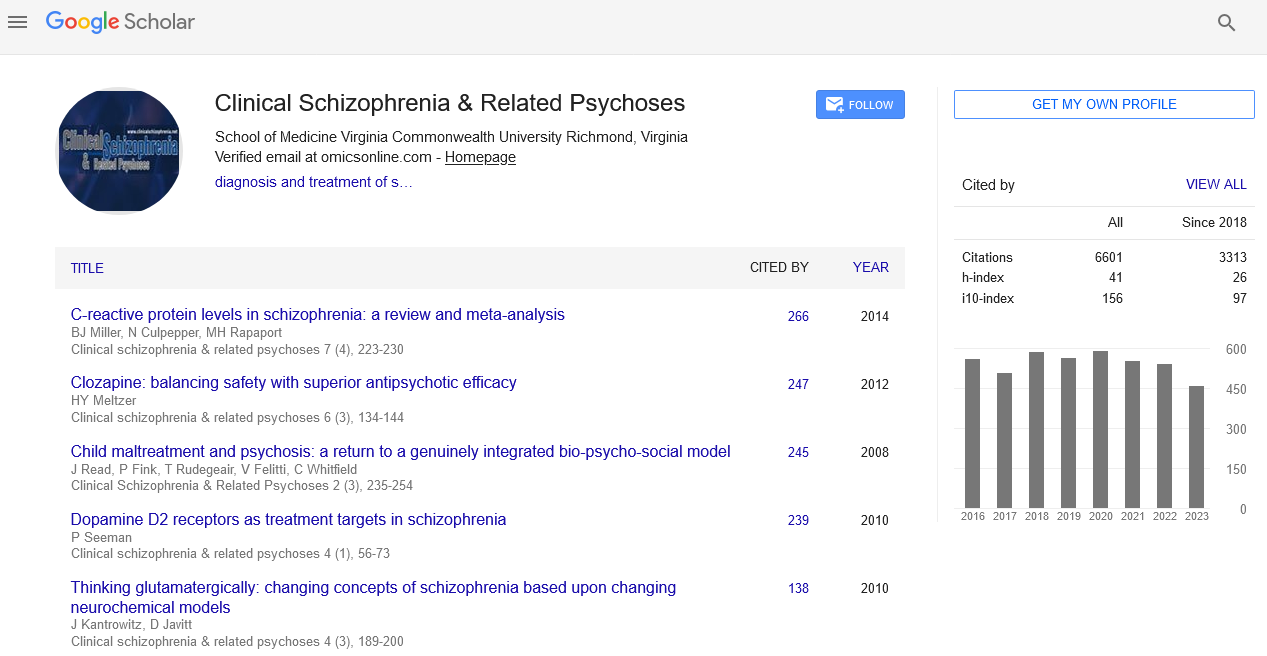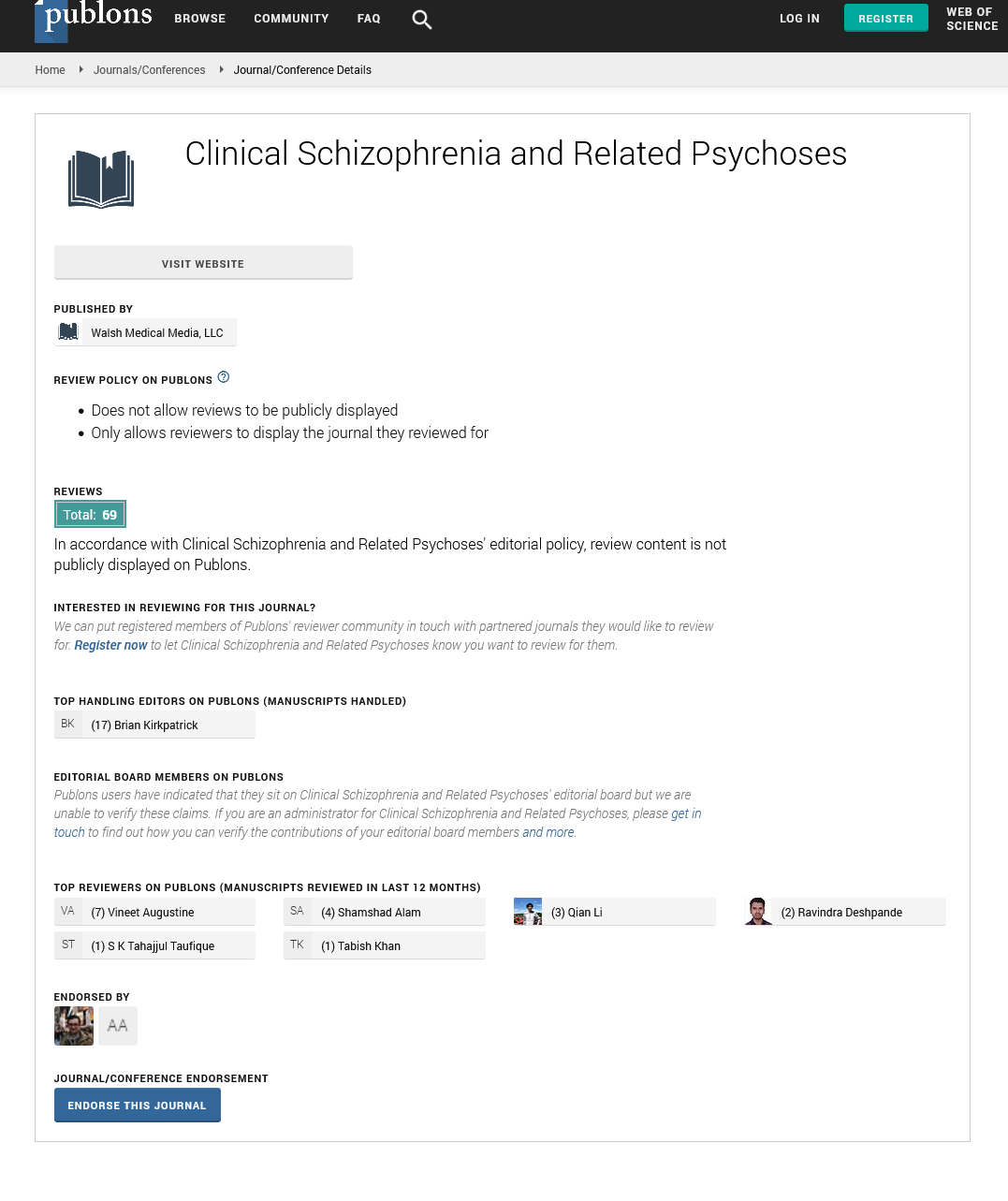Review Article - Clinical Schizophrenia & Related Psychoses ( 2024) Volume 0, Issue 0
The Potential Link between Cytomegalovirus Infection and the Onset and Symptoms of Schizophrenia
Hamidreza Pazoki-Toroudi*, Yazdan Nazer and Shahnam ShamsabadiHamidreza Pazoki-Toroudi, Department of Physiology, Iran University of Medical Sciences, Tehran, Iran, Email: pazoki1970@gmail.com
Received: 31-May-2024, Manuscript No. CSRP-24-137684 (R); Editor assigned: 03-Jun-2024, Pre QC No. CSRP-24-137684 (PQ); Reviewed: 19-Jun-2024, QC No. CSRP-24-137684 (PQ); Revised: 27-Jun-2024, Manuscript No. CSRP-24-137684 (R); Published: 05-Jul-2024, DOI: 10.3371/CSRP.AMOS.100001
Abstract
Schizophrenia is a prevalent and severe mental illness commonly encountered by clinicians. The etiology of this chronic psychiatric disorder remains unknown. Still, evidence suggests a complex genetic and neurobiological basis that impacts early brain development, leading to a combination of psychotic symptoms such as hallucinations, delusions, and disorganization, as well as motivational and cognitive dysfunctions. Research investigating the potential link between Cytomegalovirus (CMV) infections and the development or causation of schizophrenia through antibody titer tests in serum and Cerebrospinal Fluid (CSF) analysis has produced varied and sometimes conflicting findings. Some studies have observed an increase in the level of CMV antibodies in the blood samples of individuals with schizophrenia, along with higher levels of CMV antibodies in the CSF compared to control groups. Conversely, several studies have indicated no significant difference in the levels of Serum or CSF CMV antibodies between individuals with schizophrenia and those in the control group. Some studies have suggested that exposure to CMV may lead to cognitive impairment and reduced neurocognitive performance, potentially contributing to the development of schizophrenia. The limitations of these studies include small sample sizes, non-rigorous methodologies, and a lack of diversity in ethnic and epidemiological investigations. Therefore, further research into the correlation between CMV and schizophrenia is necessary to gain insight into the etiology of these conditions.
Keywords
Cytomegalovirus • Schizophrenia • Psychotic disorders
Introduction
Schizophrenia is a prevalent and severe mental illness frequently encountered by clinicians in their practice. It presents both etiological and therapeutic challenges due to its characteristic psychotic symptoms and the often associated social and occupational decline. This chronic psychiatric disorder has a diverse genetic and neurobiological basis that affects early brain development, resulting in a combination of psychotic symptoms such as hallucinations, delusions, and disorganization, as well as motivational and cognitive dysfunctions [1,2]. It is important to bear in mind that around 1 in 10,000 adults experience the onset of schizophrenia annually, the rate ratio of schizophrenia occurrence in males compared to females is 1.4:1, and the median lifetime morbid risk for schizophrenia is estimated to be 7.2 per 1,000 persons. Moreover, the combination of population growth and aging has resulted in a substantial and growing disease burden associated with schizophrenia, especially in middle-income countries [3-5]. The viral hypothesis, which has been under serious consideration for over 70 years, suggests a potential link between viruses and the development of schizophrenia. Despite this, no specific virus has been conclusively identified as a risk factor for the disorder's origin. The idea that viruses or other infectious agents may be associated with schizophrenia or bipolar disorder dates back to the 19th century and has recently regained attention [6,7].
CMV is a prevalent beta human herpesvirus type 5, distinguished by its substantial genome of approximately 235 kilobases and around 250 potential protein-encoding open reading frames. Typically, CMV infects individuals asymptomatically during childhood, establishing life-long latency. The characteristic intra nuclear inclusions of cytomegalovirus infections were initially observed in 1881 by German scientists, who initially mistook them for protozoa. CMV disease manifests when there is a viral presence and a concomitant deficiency in immunity, such as in the case of immature foetuses, AIDS patients, and transplant recipients on immunosuppressive medications. Emerging evidence points to cytomegalovirus as a potential risk factor for the development of schizophrenia [8-10]. This study aims to evaluate the association between exposure to CMV and the development of schizophrenia by reviewing the current studies and evidence to provide better insight into probable correlation and etiologies.
Literature Review
CSF and serological studies
Research examining the link between CMV infections and the development or causation of schizophrenia through antibody titer tests in serum and CSF analysis has yielded varied and sometimes contradictory findings (Table 1). On the one hand, in particular studies, an increase in the level of CMV antibodies was observed in the blood samples of individuals with schizophrenia, along with higher levels of CMV antibodies in the CSF compared to control groups [11-20]. Additionally, there were significant differences in the levels of Immunoglobulin G (IgG) and Immunoglobulin M (IgM) antibodies between the schizophrenia cases and the control groups in these studies. The researchers found that untreated individuals with recent onset schizophrenia had significantly higher levels of serum and CSF IgG antibody to CMV compared to controls without psychiatric disease. Nevertheless, levels of serum CMV IgM class antibodies were not different. Treated individuals did not show significant differences in CSF antibodies to CMV compared to controls, but their serum IgG antibody levels were negligibly higher than those of controls. Differently, found marked increases in IgM antibodies to CMV in schizophrenia patients, regardless of whether they were on or off psychotropic medications. It is worth noting revealed a significant variance in CMV serum antibody titer compared to those of CSF in individuals with schizophrenia, as well as a difference in the CSF/ serum CMV antibody ratio between patients and the control group. 68% of the patients exhibited an elevated CSF/serum antibody ratio exceeding 2 standard deviations above the mean of the controls, indicating localized antibody production in the central nervous system. The significantly elevated CMV antibody titers in the spinal fluid of groups of schizophrenic patients could potentially result from a suppression of serum antibodies resulting from treatment. Antipsychotic medications like chlorpromazine inhibit antibody production in vitro and the replication of CMV. However, to account for the increased CSF/serum ratios, it is assumed that the antibody suppression in the serum is more pronounced than in the CSF. This explanation seems unlikely due to chlorpromazine and similar drugs can cross the blood-brain barrier. An alternative and more compelling explanation for the low serum antibody titers is the suggestion that individuals at risk of schizophrenia may exhibit a diminished immunological response to CMV infection compared to the general population.
| Study | Country | Patients Detail | Age Range | Measurement | Results (+/-) |
|---|---|---|---|---|---|
| Albrecht et al., 1980 | USA | Schizophrenic: 53 Control: 26 | 17-65 Years | Neutralizing antibody assay | + |
| Gotlieb-Stematsky et al., 1981 | Israel | 18 | 20-61 Years | Indirect Immunofluorescence | - |
| Torrey et al., 1983 | USA | Schizophrenic: 178 Control: 41 | - | Enzyme-linked Immunosorbent Assay (ELISA) | + |
| Kaufmann et al., 1983 | USA | 35 46 | 27-78 Years | ELISA RIA | + |
| van Kammen et al., 1984 (5) | USA | 27 | - | ELISA | + |
| King et al., 1985 | - | Schizophrenic: 20 Control: 36 | Mean: 39 Mean: 38.5 | ELISA | - |
| King et al., 1985 | - | Schizophrenic: 143 Control: 222 | 20-96 Years 15-86 Years | Enzyme Immunoassay (EIA) | - |
| Shrikhande et al., 1985 | Ireland | Schizophrenic: 20 Control: 10 | Mean: 46.9 | ELISA | - |
| Schindler et al., 1986 | Germany | Schizophrenic: 30 Control: 30 | - | Interferon Assay | - |
| Rimon et al., 1986 | Finland | Schizophrenic: 40 Control: 40 | Mean: 40.8 Mean: 44.5 | Complement fixation | - |
| Delisi et al., 1986 | USA | Schizophrenic: 38 (18 Female, 20 Male) Control: 17 | Mean: 30 Mean: 34 | Indirect Immunofluorescence | + |
| Sierra-Honigmann et al., 1995 | USA | Schizophrenic: 48 | - | PCR-Enzyme Immunoassay (EIA) | - |
| Martin et al., 1996 | USA | 1 Female | 19 Years | PCR | + |
| Fukuda et al., 1999 | Japan | 4 Female 7 Male | 19-37 Years | EIA | - |
| Leweke et al., 2004 | USA | Schizophrenic: 38 Control: 73 | Mean: 29.1 Mean: 28 | Immunoassay | + |
| Novotna et al., 2005 | Czech Republic | 533 Male | 19-21 Years | Personality Test | - |
| Dickerson et al., 2006 | USA | Deficit Schizophrenia: 88 Nondific Schizophrenic: 235 Control: 540 | Mean: 43.3 Mean: 41.5 20-89 Years | Immunoassay | + |
| Kim et al., 2007 | USA | Total: 447 | - | EIA PCR | + |
| Niebuhr et al., 2008 | USA | Schizophrenic: 180 Control: 532 | More than 18 Yaers | EIA | - |
| Shirtsa et al., 2008 | USA | Schizophrenic: 329 | Mean: 38.4 | EIA | + |
| Krause et al., 2012 | Germany | Schizophrenic: 31 (13 Female, 18 Male) Control: 31 (13 Female, 18 Male) | Mean: 36.5 Mean: 33.7 | ELISA | + |
| Watson et al., 2013 | USA | Schizophrenic: 680 Control: 283 | Mean: 38.9 Mean: 40.8 | ELISA | - |
| Li et al., 2013 | USA | Cases: 855 Control: 1165 | - | ELISA | - |
| De Witte et al., 2015 | Netherland | Schizophrenic: 368 Control: 282 | Mean: 30.5 Mean: 34.5 | ELISA | - |
| Tanaka et al., 2016 | USA | Schizophrenic: 28 Control: 28 | - | EIA | + |
On the other hand, several studies have indicated that there is no significant difference in the levels of Serum or CSF CMV antibodies between individuals with schizophrenia and those in the control group [21- 30]. Interestingly, in some studies, the control group showed higher CMV IgG levels and greater CMV exposure compared to individuals diagnosed with schizophrenia. Reported a significantly higher CMV exposure in the control group, which remained significant even after adjusting for various potential confounding factors. These findings may seem counterintuitive but could be attributed to reduced CMV exposure in individuals with schizophrenia due to their more isolated lifestyle, a probable protective effect of CMV infection against the risk of developing schizophrenia, or indicative of altered immune function in schizophrenia [31-34]. In their study on US military personnel, observed that individuals with schizophrenia had notably lower levels of CMV IgG antibodies compared to matched controls, suggesting a potential association between higher CMV IgG antibody levels and a reduced risk of developing schizophrenia. The interaction of genetic and environmental factors may lead to immune dysregulation, with the absence of CMV IgG antibodies being a key factor. Activation of the immune system and prolonged neuro inflammation are well-established phenomena in the development and symptomatology of schizophrenia. While the autoimmune nature of schizophrenia is not fully understood, some studies indicate the possible involvement of autoimmune components in the pathways leading to schizophrenia. Given CMV's immunosuppressive effect, it may mitigate autoimmune damage and reduce the likelihood of developing schizophrenia in susceptible individuals with autoimmune reactions, which are potentially involved in the etiology and pathophysiology of schizophrenia. Therefore, individuals with similar vulnerabilities for developing schizophrenia who did not encounter CMV may be at a higher risk of developing the condition. CMV is also associated with a reduction in CD4+ cells and their activation, followed by the production of proinflammatory cytokines, including TNF-α. TNF-α signalling through endothelial cells can alter the structure of tight junctions, leading to increased blood-brain barrier permeability and changes in brain structure and function, potentially contributing to psychiatric disorders such as schizophrenia.
Findings suggested that serological evidence of CMV infection is related to impaired cognitive function in these patients [35]. The researchers proposed that treating CMV-exposed schizophrenia patients with antivirals could potentially lead to improvements in cognitive function and clinical outcomes, irrespective of specificity to schizophrenia. However, investigating the use of adjunctive Val acyclovir to alleviate symptoms of persistent schizophrenia in CMV-seropositive individuals, no significant benefit of adjunctive Val acyclovir administration was observed in schizophrenia patients with persistent illness symptoms [36-40].
Considering all the results of serological studies previously mentioned, there is no sufficient evidence to confirm CMV as an etiology of schizophrenia or any direct association between them. The studies lack accuracy due to low sample size and study population, not precise methodology, and lack of ethnic and epidemiological diversity investigations.
Discussion
Brain studies
Several studies have suggested that exposure to CMV may lead to cognitive impairment and reduced neurocognitive performance, potentially contributing to the development of schizophrenia (Table 2) [41]. Discovered that male patients infected with CMV exhibited a reduced dentate gyrus size compared to CMV-positive females and the control group [42]. This result could be due to the detrimental effects of CMV on the granule cells of the dentate gyrus over an extended period [43]. Additionally, a Magnetic Resonance Imaging (MRI) study revealed that CMV-infected foetuses exhibited brain developmental abnormalities influenced by genetic and environmental factors, which may increase the risk of schizophrenia [44]. Furthermore, research on 69 schizophrenia patients showed that CMV IgG antibodies were present in those with reduced hippocampal size and weakened episodic verbal memory [45].
| Study | Country | Patient/Samples | Age Range | Measurement | Results (+/-) |
|---|---|---|---|---|---|
| Shearer et al., 1964 | USA | 1 Male | 9 Years | Intelligence Test, | - |
| Aulakh et al., 1981 | USA | Schizophrenic: 6 Control: 6 | - | DNA Hybridization | - |
| Stevens et al., 1984 | USA | Schizophrenic: 15 Control: 9 | - | Immunocytochemical Staining of Brain | + |
| Taylor et al., 1985 | England | Temporal Cortex Tissue: 25 Temporal Lobe Tissue: 18 | - | Dot-blot DNA Hybridization | - |
| Carter et al., 1987 | England | Schizophrenic: 20 Control: 20 | 22-84 Years 24-67 Years | Dot-blot DNA Hybridization | - |
| Moises et al., 1988 | England | Schizophrenic: 7 Control: 9 | 23-80 Years | Southern Blot DNA Hybridization | + |
| Alexander et al., 1992 | USA | Schizophrenic: 8 Control: 8 | - | PCR | - |
| Sierra-Honigmann et al., 1995 | Germany | 2 Schizophrenic Male 1 Schizophrenic Female Control: 3 | 42 and 49 Years 35 Years Age Matched | PCR-EIA | - |
| Taller et al., 1996 | USA and Germany | Schizophrenic: 31 Control: 23 | - | PCR | - |
| Conejero-Goldberg et al., 2003 | USA | Schizophrenic: 14 Control: 26 | Mean: 39.9 Mean:48.7 | PCR | - |
| Hoffmann et al., 2010 | Israel | 79 Pregnant Female | Gestational age 23-39 weeks | MRI | + |
| Houenou et al., 2014 | France | Schizophrenic: 69 Control: 102 | Mean: 39.4 Mean: 37.8 | MRI | + |
| Andreou et al., 2020 | Norway | Schizophrenic: 114 Control: 396 | - | MRI, Solid-phase Immunoassay | (+) Male (-) Female |
However, studies on screening several areas of the post-mortem brain, such as the orbital frontal brain, temporal cortex, and hippocampus from schizophrenia patients for evidence of CMV genome using molecular hybridization and Polymerase Chain Reaction (PCR) showed no sign of CMV DNA sequences in both patients and thereby refuting the hypothesis that CMV reactivation in the brain could cause schizophrenia [46-54].
Congenital CMV
Research indicates a direct link between congenital CMV exposure and an elevated risk of schizophrenia in offspring [55-58]. This association suggests that chronic maternal CMV infection impacts neonatal innate immune markers, potentially leading to deficient fetal immune responses and an increased risk of psychosis and schizophrenia. However, it is important to note that some studies have not found a clear relationship between congenital CMV and schizophrenia (Table 3) [59,60].
| Study | Country | Patient | Age Range | Measurement | Results (+/-) |
|---|---|---|---|---|---|
| Buka et al., 2001 | USA | Schizophrenic: 13 Control: 54 | - | EIA | + |
| Dalman et al., 2008 | Sweden | 1.2 Million | 0-12 Years | ICD | + |
| Blomstrom et al., 2012 | Sweden | Schizophrenic: 47 Control: 524 | - | Immunoassay | + |
| Blomstrom et al., 2015 | Sweden | Schizophrenic: 47 Control: 123 | - | Immunoassay | + |
Pathogenesis
CMV induces localized brain inflammation, leading to increased dopamine levels and potential behavioural changes such as schizophrenia. CMV is known to cause encephalitis and persist in the host's nerve ganglia. Reactivation of CMV may occur during periods of weakened immune function due to physical or emotional stress, potentially leading to schizophrenia symptoms. While the immune system of individuals with schizophrenia is typically not compromised, other mechanisms may be at play. Studies have indicated elevated levels of anti-Glutamic Acid Decarboxylase (GAD) antibodies in autoimmune conditions like type-1 diabetes and stiff person syndrome and have identified molecular mimicry between GAD and CMV peptides. Reduced GAD levels in post-mortem brain samples of individuals with schizophrenia may explain previous difficulties in detecting CMV DNA in such samples. Additionally, research has linked smaller temporal lobe sizes to schizophrenia symptoms [61-63].
Research suggests that schizophrenia may be associated with immune system dysregulation, as indicated by elevated levels of Interleukin (IL)- 1β, Tumor Necrosis Factor (TNF)-α, and increased NF-κB activation. Additionally, signs of inflammation have been observed in the brains of individuals with schizophrenia. One potential mechanism through which CMV infections could impact immune function in the brain is by triggering tryptophan catabolism and increasing pro inflammatory cytokines. Tryptophan, an essential amino acid, can be metabolized into serotonin or other compounds through the kynurenine pathway, some of which modulate NMDA receptor activity and neurotransmitter availability. Activation of the kynurenine pathway has been implicated in the pathophysiology of schizophrenia. The precise ways in which altered tryptophan metabolism contributes to schizophrenia symptoms and tics are not fully understood. It is hypothesized that it may reflect immune system activation or that kynurenine and its metabolites could directly exert toxic effects in the basal ganglia and central nervous system. Further research is needed to elucidate the specific role of CMV as a potential factor in schi zophrenia.
Conclusion
Numerous studies have investigated the presence of CMV in individuals with schizophrenia to determine if there is a discernible relationship between CMV and the disorder. Research exploring the connection between CMV infection and the onset or causation of schizophrenia, using brain tissue samples and antibody titer tests in serum and CSF analysis, has produced diverse and at times conflicting results. In light of the serological studies mentioned, there is insufficient evidence to establish CMV as a cause of schizophrenia definitively or to demonstrate a direct association between the two. The limitations of these studies include small sample sizes, nonrigorous methodologies, and a lack of diversity in ethnic and epidemiological investigations. Therefore, further research into the correlation between CMV and schizophrenia is necessary to gain insight into the etiology of these conditions.
References
- McCutcheon, Robert, Tiago Reis Arques and Oliver Howes, “Schizophrenia-An Overview”. JAMA Psychiatry 77 (2020): 201-210.
- Kahn, Rene, Iris Sommer, Robin Murray and Andreas Meyer-Lindenberg, et al. “Schizophrenia”. Nat Rev Dis Primers 1 (2015): 15067.
- Hafner, Heinz and Wolfram an der Heiden. “Epidemiology of Schizophrenia”. Can J Psychiatry 42 (1997): 39-51.
- McGrath, John, Sukanta Saha, David Chant and Joy Welham. “Schizophrenia: A Concise Overview of Incidence, Prevalence and Mortality”. Epidemiol Rev 30 (2008): 67-76.
- Charlson, Fiona, Alize J Ferrari, Damian F Santomauro and Sandra Diminic, et al. “Global Epidemiology and Burden of Schizophrenia: Findings from the Global Burden of Disease Study 2016”. Schizophr Bullkj 44 (2018): 1195-1203.
- O'Reilly, Richard. “Viruses and Schizophrenia”. Aust N Z J Psychiatry 28 (1994): 222-228.
- van, Jim and Shitij Kapur. “Schizophrenia”. Lancet 374 (2009): 635-645.
- I, Kosugi. “Cytomegalovirus (CMV)”. Uirusu 60 (2010): 209-220.
- Ho, Monto. “The History of Cytomegalovirus and its Diseases”. Med Microbiol Immunol 197 (2008): 65-73.
- Torrey, Fuller, Markus Leweke, Markus Schwarz and Norbert Mueller, et al. “Cytomegalovirus and Schizophrenia”. CNS Drugs 20 (2006): 879-85.
- Antti, Ahokas, Ranan Rimon, Koskiniemi Marjaleena and Vaheri Antti, et al. “Viral Antibodies and Interferon in Acute Psychiatric Disorders”. J Clin Psychiatry 48 (1987): 194-196. [Crossref]
- Srikanth, S, V Ravi, K Shenoy Poornima and KT Shetty, et al. “Viral Antibodies in Recent Onset, Nonorganic Psychoses: Correspondence with Symptomatic Severity”. Biol Psychiatry 36 (1994):517-21.
- Albrecht, Paul, Elizabeth Fuller Torrey, Elizabeth Boone and John T Hicks, et al. “Raised Cytomegalovirus-Antibody Level in Cerebrospinal Fluid of Schizophrenic Patients”. Lancet 2 (1980): 769-772.
- Kaufmann, Charles, Daniel Weinberger, Robert H Yolken and Fuller Torrey, et al. “Viruses and Schizophrenia”. Lancet (1983): 1136-1137.
- Kammen, DP van, L Mann, M Scheinin and WB van Kammen, et al. “Spinal Fluid Monoamine Metabolites and Anti-Cytomegalovirus Antibodies and Brain Scan Evaluation in Schizophrenia”. Psychopharmacol Bull 20 (1984): 519-522. [Crossref]
- Leweke, Markus, Christoph Gerth, Dagmar Koethe and Joachim Klosterkotter, et al. “Antibodies to infectious agents in individuals with recent onset schizophrenia”. Eur Arch Psychiatry Clin Neurosci 254 (2004): 4-8.
- Lydia Krause, Daniela, Elif Weidinger, Judith Matz and Agnes Wildenauer, et al. “Infectious Agents are Associated with Psychiatric Diseases”. Ment Illn 4 (2012): e10.
- Torrey, E Fuller, Robert H Yolken and C Jack Winfrey. “Cytomegalovirus Antibody in Cerebrospinal Fluid of Schizophrenic Patients Detected By Enzyme Immunoassay”. Science 216 (1982): 892-894.
- Fukuda, Rimmei, Tsukasa Sasaki, Hiroshi Kunugi and Shinichiro Nanko. “No Changes in Paired Viral Antibody Titers during the Course of Acute Schizophrenia”. Neuropsychobiology 40 (1999):57-62.
- Dickerson, Faith, Brian Kirkpatrick, John Boronow and Cassie Stallings, et al. “Deficit Schizophrenia: Association with Serum Antibodies to Cytomegalovirus”. Schizophr Bull 32 (2006): 396-400.
- Stevens, Janice, John Langloss and Paul Albrecht. “A Search for Cytomegalovirus and Herpes Viral Antigen in Brains of Schizophrenic Patients”. Arch Gen Psychiatry 41 (1984): 795-801.
- King, DJ, SJ Cooper, JA Earle and SJ Martin, et al. “Serum and CSF Antibody Titres to Seven Common Viruses in Schizophrenic Patients”. Br J Psychiatry 147 (1985): 145-149.
- King, DJ, SJ Cooper, JA Earle and SJ Martin, et al. “A Survey of Serum Antibodies to Eight Common Viruses in Psychiatric Patients”. Br J Psychiatry 147 (1985):137-144.
- Shrikhande, Satish, Steven R Hirsch, JC Coleman and Michael A Reveley, et al. “Cytomegalovirus and Schizophrenia. A Test of a Viral Hypothesis”. Br J Psychiatry 146 (1985):503-506.
- Torrey, Fuller, Michael Peterson, William Brannon and William Carpenter, et al. “Immunoglobulins and Viral Antibodies in Psychiatric Patients”. Br J Psychiatry 132 (1978): 342-348.
- Stematsky, T Gotlieb, J Zonis, A Arlazoroff and T Mozes, et al. “Antibodies to Epstein-Barr Virus, Herpes Simplex Type 1, Cytomegalovirus and Measles Virus in Psychiatric Patients”. Arch Virol 67 (1981): 333-339.
- Rimon, R, A Ahokas and J Palo “Serum and Cerebrospinal Fluid Antibodies to Cytomegalovirus in Schizophrenia”. Acta Psychiatr Scand 73 (1986): 642-644.
- Schindler, L, M Leroux, J Beck and HW Moises, et al. “Studies of Cellular Immunity, Serum Interferon Titers, and Natural Killer Cell Activity in Schizophrenic Patients”. Acta Psychiatr Scand 73 (1986): 651-657.
- Tanaka, Teppei, Taro Matsuda, Lindsay Hayes and Shuojia Yang, et al. “Infection and Inflammation in Schizophrenia and Bipolar Disorder”. Neurosci Res 115 (2017): 59-63.
- Dickerson, Faith, Cassie Stallings, John Boronow and Andrea Origoni, et al. “Double Blind Trial of Adjunctive Valacyclovir in Individuals with Schizophrenia who are Seropositive for Cytomegalovirus”. Schizophr Res 107 (2009): 147-149.
- de Witte, Lot, Hans van Mierlo, Manja Litjens and Hans Klein, et al. “The Association between Antibodies to Neurotropic Pathogens and Schizophrenia: A Case-Control Study”. NPJ Schizophr 1 (2015): 15041.
- Delisi, Lynn, Suzanne Smith, Joel Hamovit and Elizabeth Maxwell, et al. “Herpes Simplex Virus, Cytomegalovirus and Epstein-Barr Virus Antibody Titres in Sera from Schizophrenic Patients.” Psychol Med 16 (1986): 757-763.
- Niebuhr, David, Amy Millikan, Robert Yolken and Yuanzhang Li, et al. “Results from a Hypothesis Generating Case-Control Study: Herpes Family Viruses and Schizophrenia among Military Personnel”. Schizophr Bull 34 (2008): 1182-1188.
- Li, Yuanzhang, Natalya Weber, Jared Fisher and Robert Yolken, et al. “Association between Antibodies to Multiple Infectious and Food Antigens and New Onset Schizophrenia among US Military Personnel”. Schizophr Res 151 (2013): 36-42.
- Shirts, Brian, Konasale Prasad, Michael Pogue-Geile and Faith Dickerson, et al. “Antibodies to Cytomegalovirus and Herpes Simplex Virus 1 Associated with Cognitive Function in Schizophrenia”. Schizophr Res 106 (2008): 268-274.
- Fuller, Torrey, Yolken Robert and Albrecht Paul. “Cytomegalovirus as a Possible Etiological Agent in Schizophrenia”. In: Morozov PV, editor Research on the Viral Hypothesis of Mental Disorders: S.Karger AG; 12 (1983): 150-160.
- Honigmann, Sierra, KM Carbone and RH Yolken. “Polymerase Chain Reaction (PCR) Search for Viral Nucleic Acid Sequences in Schizophrenia”. Br J Psychiatry 166 (1995): 55-60.
- Martin, John. “Simian Cytomegalovirus-Related Stealth Virus Isolated from the Cerebrospinal Fluid of a Patient with Bipolar Psychosis and Acute Encephalopathy”. Pathobiology 64 (1996): 64-66.
- Novotna, Martina, Jitka Hanusova, Jiri Klose and Marek Preiss, et al. “Probable Neuro Immunological Link between Toxoplasma and Cytomegalovirus Infections and Personality Changes in the Human Host”. BMC Infect Dis 5 (2005): 54.
- Jin Kim, Jung, Brian Shirts, Madhulika Dayal and Silviu‐alin Bacanu, et al. “Are Exposure to Cytomegalovirus and Genetic Variation on Chromosome 6p Joint Risk Factors for Schizophrenia?” Ann Med 39 (2007): 145-153.
- Watson, AMM, KM Prasad, L Klei and JA Wood, et al. “Persistent Infection with Neurotropic Herpes Viruses and Cognitive Impairment”. Psychol Med 43 (2013): 1023-1031. [Crossref]
- Andreou, Dimitrios, Kjetil Nordbo Jorgensen, Stener Nerland and Kristine Engen, et al. “Cytomegalovirus Infection Associated with Smaller Dentate Gyrus in Men with Severe Mental Illness”. Brain Behav Immun 96 (2021): 54-62.
- Drew, Liam, Stefano Fusi and Rene Hen. “Adult Neurogenesis in the Mammalian Hippocampus: Why the Dentate Gyrus?” Learn Mem 20 (2013): 710-729.
- Hoffmann, Chen, Rachel Grossman, Inna Bokov and Shlomo Lipitz, et al. “Effect of Cytomegalovirus Infection on Temporal Lobe Development in Utero: Quantitative Mri Studies”. Eur Neuropsychopharmacol 20 (2010): 848-854.
- Houenou, J, MA d'Albis, C Daban and N Hamdani, et al. “Cytomegalovirus Seropositivity and Serointensity are Associated with Hippocampal Volume and Verbal Memory in Schizophrenia and Bipolar Disorder”. Prog Neuropsychopharmacol Biol Psychiatry 48 (2014): 142-148.
- Taller, Alla, David M Asher, Kitty Pomeroy and BA Eldadah, et al. “Search for Viral Nucleic Acid Sequences in Brain Tissues of Patients with Schizophrenia Using Nested Polymerase Chain Reaction”. Arch Gen Psychiatry 53 (1996): 32-40.
- Aulakh, Gurmit, Joel Kleinman, Harris S Aulakh and Richard Wyatt. “Search for Cytomegalovirus in Schizophrenic Brain Tissue”. Proc Soc Exp Biol Med 167 (1981): 172-174.
- Taylor, GR, TJ Crow, T Higgins and G Reynolds. “Search for Cytomegalovirus in Postmortem Brain Tissue from Patients With Huntington's Chorea and Other Psychiatric Disease by Molecular Hybridization Using Cloned DNA”. J Neuropathol Exp Neurol 44 (1985): 176-184.
- Moises, Hans, Rudiger Rudiger, Gavin Reynolds and Bernhard Fleckenstein. “Human Cytomegalovirus Dna in the Temporal Cortex of a Schizophrenic Patient”. Eur Arch Psychiatry Neurol Sci 238 (1988): 110-113.
- Alexander, Robert, Stephen Spector, M Casanova and J Kleinman, et al. “Search for Cytomegalovirus in the Postmortem Brains of Schizophrenic Patients Using the Polymerase Chain Reaction”. Arch Gen Psychiatry 49 (1992): 47-53.
- Carter, GI, GR Taylor and TJ Crow. “Search for Viral Nucleic Acid Sequences in the Post Mortem Brains of Patients with Schizophrenia and Individuals who have Committed Suicide”. J Neurol Neurosurg Psychiatry 50 (1987): 247-251.
- Conejero-Goldberg, Concepcion, E Fuller Torrey and Robert H Yolken. “Herpesviruses and Toxoplasma Gondii in Orbital Frontal Cortex of Psychiatric Patients”. Schizophr Res 60 (2003): 65-69.
- Taylor, GR and TJ Crow. “Viruses in Human Brains: A Search for Cytomegalovirus and Herpes Virus 1 Dna in Necropsy Tissue from Normal and Neuropsychiatric Cases”. Psychol Med 16 (1986):289-95.
- Shearer, Marshall and Stuart Finch. “Periodic Organic Psychosis Associated with Recurrent Herpes Simplex". N Engl J Med 271 (1964): 494-497.
- Dalman, Christina, Peter Allebeck, David Gunnell and Glyn Harrison, et al. “Infections in the CNS during Childhood and the Risk of Subsequent Psychotic Illness: A Cohort Study of More Than One Million Swedish Subjects”. Am J Psychiatry 165 (2008):59-65.
- Cheslack-Postava, Keely and Alan Brown. “Prenatal Infection and Schizophrenia: A Decade of Further Progress”. Schizophr Res 247 (2022): 7-15.
- Blomstrom, Asa, Hakan Karlsson, Susanne Wick and Shuojia Yang, et al. “Maternal Antibodies to Infectious Agents and Risk for Non-Affective Psychoses in the Offspring-A Matched Case-Control Study”. Schizophr Res 140 (2012): 25-30.
- Blomstrom, A, RM Gardner, C Dalman and RH Yolken, et al. “Influence of Maternal Infections on Neonatal Acute Phase Proteins and Their Interaction in the Development of Non-Affective Psychosis”. Transl Psychiatry 5 (2015): e502.
- Buka, Stephen, Ming Tsuang and Fuller Torrey. “Maternal Infections and Subsequent Psychosis among Offspring”. Arch Gen Psychiatry 58 (2001):1032-1037.
- Khandaker, Zimbron, Lewis G and Jones PB. “Prenatal Maternal Infection, Neurodevelopment and Adult Schizophrenia: A Systematic Review of Population-Based Studies”. Psychol Med 43 (2013):239-257.
- Hiemstra, Hoebert, Nanette Schloot, Peter van Veelen and Sabine Willemen, et al. “Cytomegalovirus in Autoimmunity: T cell Crossreactivity to Viral Antigen and Autoantigen Glutamic Acid Decarboxylase”. Proc Natl Acad Sci USA 98 (2001):3988-3991.
- Akbarian, Schahram, Molly Huntsman, James Kim and Alireza Tafazzoli, et al. “Gabaa Receptor Subunit Gene Expression in Human Prefrontal Cortex: Comparison of Schizophrenics and Controls”. Cereb Cortex 5 (1995):550-560.
- Nestor, Paul, Toshiaki Onitsuka, Ronald Gurrera and Margaret Niznikiewicz, et al. “Dissociable Contributions of MRI Volume Reductions of Superior Temporal and Fusiform Gyri to Symptoms and Neuropsychology in Schizophrenia”. Schizophr Res 91 (2007):103-106.
Citation: Hamidreza, P Toroudi, Yazdan Nazer and Shahnam Shamsabadi. "The Potential Link between Cytomegalovirus Infection and the Onset and Symptoms of Schizophrenia." Clin Schizophr Relat Psychoses 18 (2024). DOI: 10.3371/CSRP.AMOS.100001
Copyright: �© 2024 Toroudi HP, et al. This is an open-access article distributed under the terms of the Creative Commons Attribution License, which permits unrestricted use, distribution, and reproduction in any medium, provided the original author and source are credited. This is an open access article distributed under the terms of the Creative Commons Attribution License, which permits unrestricted use, distribution, and reproduction in any medium, provided the original work is properly cited.






